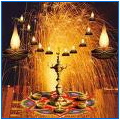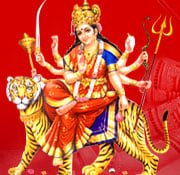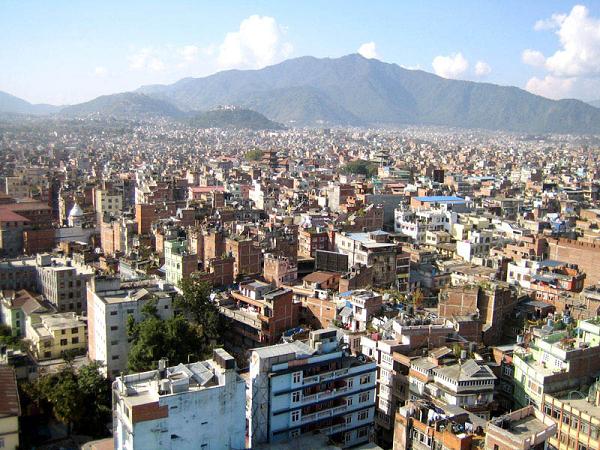guest |
January 14th, 2013
Makar Sankranti is one of the most important Hindu celebrations. It is perhaps the only Hindu festival which falls on the same date every year, on January 14th.
Makar Sankranti is a joyous occasion because it celebrates the sun god’s journey to the northern hemisphere. The sun and its journey represent spiritual light, knowledge, and virtue, but the day is also a harvest festival.
Makar Sankranti celebrations vary greatly across India, but one of the most popular activities during this time is to fly kites. Watch this video clip on to see how one Indian town celebrates Makar Sankranti:
Read more.. »
guest |
November 20th, 2012
Today is Universal Children’s Day, a day to remind people across the globe of the rights and welfare of children.

Children's Day highlights the importance of welfare.
The day was first established in 1954 by the General Assembly of the UN as a response to child labour. The day highlights the inhumane aspects of child labour: the long hours, dangerous work conditions, and denial of education.
In most countries, the situation of child labourers has improved drastically since 1954, but there are still over 215 million child labourers around the world today. The UN is worried about the current trends because it seems that the number of child labourers is on the rise in poorer countries. The UN has therefore declared to eliminate child labour by 2020. This declaration fits into the Millennium Development Goals (MDGs), which all have a target date in 2015. Although the MDGs are for all human kind, they are primarily about children.
“We were all children once,” is the message from the secretary general on Universal Children’s Day. “We all share the desire for the well-being of our children, which has always been and will continue to be the most universally cherished aspiration of humankind.”
Happy Universal Children’s Day everyone!
Read more:
World Day Against Child Labour – June 12th
Diwali is the Hindu Festival of Lights 
Diwali is a five-day long celebration and means as much to Hindus as Christmas does to Christians. Diwali signifies the renewal of life and heralds the beginning of winter – when sowing crops can start.
Diwali is also a Sikh festival, especially celebrating the release from prison of the sixth guru, Hargobind, in 1619. However, Sikhs had celebrated Diwali for many years before that. The foundation stone of the Golden Temple at Amritsar, the holiest place in the Sikh world, was laid on Diwali in 1577. For Jains, Diwali marks the attainment of Moksha (Nirvana, or eternal bliss) by the founder of Jainism, Lord Mahavira.
Find out more about Diwali.
guest |
October 17th, 2012
“Wherever men and women are condemned to live in extreme poverty, human rights are violated. To come together to ensure that these rights be respected is our solemn duty.” Joseph Wresinski, the founder of ADT Fourth World
Today is the International Day for the Eradication of Poverty. Nearly half of the world’s population (that’s three billion people) live on less than $2.5 a day. 1.1 billion people have inadequate access to water and 2.6 billion people live without basic sanitation. Approximately 790 million people in the developing world are still chronically undernourished, almost two-thirds of them residing in Asia and the Pacific. 18 million deaths a year, one third of the world’s deaths, are caused by poverty.
Nearly half of the world’s population (that’s three billion people) live on less than $2.5 a day. 1.1 billion people have inadequate access to water and 2.6 billion people live without basic sanitation. Approximately 790 million people in the developing world are still chronically undernourished, almost two-thirds of them residing in Asia and the Pacific. 18 million deaths a year, one third of the world’s deaths, are caused by poverty.
All the more shockingly, an average cow in the European Union receives more than £1.40 a day in subsidies, which is more than the amount that half the world’s population survives on.
This year’s theme for International Day for the Eradication of Poverty is “Ending the Violence of Extreme Poverty: Promoting Empowerment and Building Peace.” Just like the quote above by Joseph Wresinski, this theme recognizes poverty as a human rights violation, rather than simply as a low income level.
Read more.. »
guest |
October 16th, 2012
Navaratri, one of the greatest Hindu festivals, begins today. Navaratri means ‘nine nights’ in Sanskri. The celebration symbolises the triumph of good over evil and the festivities last for nine days. Navratri takes place at the beginning of October around harvest time.
Navaratri means ‘nine nights’ in Sanskri. The celebration symbolises the triumph of good over evil and the festivities last for nine days. Navratri takes place at the beginning of October around harvest time.
Most Hindus fast during Navaratri and only have a single meal during the day. Despite the fast, food is very important in Navaratri and there are many special Navaratri dishes such as banana chips and aloo raita. Fruits and dairy dishes are very popular, whereas non-vegetarian food is totally avoided during the celebrations. The internet offers several Navartri food and cooking guides. For this year’s Navaratri, India Today suggests a range of “mouth-watering twists” to tradition recipes, that will turn the “fast into a feast.”
Read more.. »
guest |
October 15th, 2012
It is estimated that 60% of chronically hungry people are women and girls. Today is International Day of Rural Women, a day that recognizes the vital role of rural women, including indigenous women, in enhancing agricultural and rural development, improving food security and eradicating rural poverty.

60% of chronically hungry people are women.
The day is purposefully held a day before World Food Day in order to highlight the role rural women play in food production.
The International Day of Rural Women was first observed at a significant time in October 2008. 2006, 2007, and 2008 were the years of the global food crisis when prices of staple foods rose dramatically around the world. Although prices declined slightly right afterwards they spiked again in 2010 and have been high since. UN Women Watch writes that food prices are “likely to remain high and volatile over the next decade.”
Poor rural households feel the global crises the hardest. The poorer the household the more its members have to change the way they live to cope with the crises.
Read more.. »
guest |
October 1st, 2012
In 2008, for the first time in history, more than half of the world’s population was living in cities.

Today more than 50% of the world's inhabitants live in cities.
Today is World Habitat Day, and this year’s theme is Changing Cities, Building Opportunities.
World Habitat Day was first observed in 1986. The purpose of this day is to highlight the role of shelter as a basic human right, and reflect on the state of our cities and towns around the world. This year’s urban theme was chosen because cities are engines of growth, and across the globe more and more people are moving into cities in the hope of a better future. According to research done by the Massachusetts Institute of Technology cities make up only 2% of the world’s surface, but they house more than 50% of the world’s population, consume 70% of the world’s energy, and are responsible for the 80% of the world’s carbon footprint. Research from Yale predicts that by 2030 10% of the world’s surface could be urban, most of this expansion happening in Asia…
Read more.. »
To honour the spirit of the Olympics 2012, 204 poems from around the world, from Afghanistan to Zimbabwe, have been collected from each of the 204 participating countries by the Scottish Poetry Library.
Here is the second set of ten from Asia. Enjoy!
- Iraq: My Apologies
- Israel: Returning to Tel Aviv
- Jordan: Dog’s Tail
- Japan: Two Tokyos
- Kazakhstan: Summer
- Kuwait: from My Dreams Often Humble Themselves
- Kyrgyzstan: from Nomad in the sunset
- Lebanon: ‘Our cries, she used to say…’
- Malaysia: Modern Secrets
- Maldives: Realities of Island Life
Follow the link to read the first set of ten Asian poems
The poems selected are often not by the most notable poet a country has produced. Some of them are funny or light-hearted. Often they are snapshots of lives rather than grand narratives. And some of the choices may be controversial. However, they all give a glimpse of lives in countries spanning the globe. Together these poems depict a world united not only by sport, but by emotions that are universal and need no translator other than the heart.
guest |
August 10th, 2012
Janmashtami is an important day in the Hindu calendar because it marks the birth of Krishna, one of the most popular Hindu gods.

Dahi Handi
Most Hindus believe that Krishna is the avatar, or incarnation, of Vishnu, one of the five primary forms of God. Vishnu is the preserver and protector of the universe. Vishnu usually appears in a human body, with blue-coloured skin and four arms. Krishna, on the other hand, has a variety of forms. Most popular forms are Krishna as a blue god-child, as a divine hero, or as a model lover.
Krishna is always the centre of Janmashatami, but the day is celebrated differently across India. Around Mumbai, in the state of Maharashtra, it’s common to celebrate with a sport called Dahi Handi. In Dahi Handi, a handi, a clay pot filled with buttermilk, is first hung to a high location. A group of men then forms a human pyramid beneath the handi, and the topmost person in the pyramid tries to break the claypot. As buttermilk from the broken handi drips down the human pyramid it symbolizes unity.
Read more.. »
To honour the spirit of the Olympics 204 poems from around
the world, from Afghanistan to Zimbabwe, have been collected from each of the 204 participating countries by the Scottish Poetry Library.
Here are the first ten from Asia. Enjoy
- Afghanistan: The story of my country
- Azerbaijan: The poet’s voice
- Bahrain: All of them
- Bangladesh: Mon-doria
- Bhutan: A lesson in light
- Brunei Darussalam: Brothers, your cries…
- Georgia: Circle and rectangle
- Hong Kong: Floral Apron
- India: Homecoming
- Iran: An Iranian Professor I know asked me…
The poems selected are often not by the most notable poet a country has produced. Some of them are funny or light-hearted. Often they are snapshots of lives rather than grand narratives. And some of the choices may be controversial. However, they all give a glimpse of lives in countries spanning the globe. Together these poems depict a world united not only by sport, but by emotions that are universal and need no translator other than the heart.




 Nearly half of the world’s population (that’s three billion people) live on less than $2.5 a day. 1.1 billion people have inadequate access to water and 2.6 billion people live without basic sanitation. Approximately 790 million people in the developing world are still chronically undernourished, almost two-thirds of them residing in Asia and the Pacific. 18 million deaths a year, one third of the world’s deaths, are caused by poverty.
Nearly half of the world’s population (that’s three billion people) live on less than $2.5 a day. 1.1 billion people have inadequate access to water and 2.6 billion people live without basic sanitation. Approximately 790 million people in the developing world are still chronically undernourished, almost two-thirds of them residing in Asia and the Pacific. 18 million deaths a year, one third of the world’s deaths, are caused by poverty. Navaratri means ‘nine nights’ in Sanskri. The celebration symbolises the triumph of good over evil and the festivities last for nine days. Navratri takes place at the beginning of October around harvest time.
Navaratri means ‘nine nights’ in Sanskri. The celebration symbolises the triumph of good over evil and the festivities last for nine days. Navratri takes place at the beginning of October around harvest time.




 Hello, I'm Deborah Swallow and, for the last fifteen years, I've worked in over thirty countries addressing the complexities of people working internationally across multiple cultures, so individuals and organisations alike can gain an authentic competitive edge and win in international markets.
Hello, I'm Deborah Swallow and, for the last fifteen years, I've worked in over thirty countries addressing the complexities of people working internationally across multiple cultures, so individuals and organisations alike can gain an authentic competitive edge and win in international markets. 